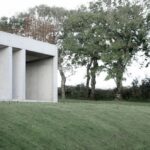Roch Castle Wales, Ancient Pembrokeshire Building, Old Welsh Fortification Project Design
Roch Castle, Wales : Historic Pembrokeshire Building
Renewal of Historic Building in Wales design by Acanthus Holden, UK
8 Oct 2012
Roch Castle, Pembrokeshire
Architects: Acanthus Holden
Roch Castle, Pembrokeshire for the Retreats Group
Keith Griffiths was brought up in St David’s between 1960 and 72. He left the U.K in 1982 and set up his own architectural practice in Hong Kong in 1985. He acquired the castle in 2008 following long negotiations with the previous owners. The castle was reopened as a corporate retreat on behalf of the Griffiths Roch Foundation in January 2012 and can be found at www.retreatsgroup.co.uk.
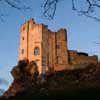
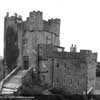
images : Castle Photography in Haverfordwest
Acanthus Holden, based in Pembrokeshire, was employed by Keith Griffiths in 2008 to work as project architects on Roch Castle and two other Retreats Group properties in Pembrokeshire. Though still based in Hong Kong, Keith Griffiths has remained closely involved in the projects from concept development through to detailed design and specification.
Roch Castle has been directed by Peter Holden, who also provided the conservation input, with project architect Mark Vines as well as a full time Clerk of Works, Whitney John.
Roch Castle was purchased with the aim of creating an exclusive corporate retreat in West Wales, fitted out to an unparalleled level of quality. From the outset, the project has been rigorously marshalled by a design philosophy based on the faithful conservation of the medieval fabric contrasting with the crisply engineered interiors appropriate to the building’s new life.
The restoration has followed the 1910 room and floor layout to create six en-suite bedrooms, three reception rooms and a dining room with kitchen. The castle was built in the 13thC as a ‘D’ shaped defensive tower on top of a Pre-Cambrian volcanic plug. Following a partial collapse probably in the 15thC, a square tower extension was added to the south elevation.
Slighted by Cromwell the castle was left ruinous till 1900. The castle was restored and converted into a country house by Viscount St Davids between 1900 and 1920.
Twentieth century alterations included the introduction of new insitu concrete floors and staircases and the construction of a new annexe on three levels to the north elevation.
The internal accommodation is spread over 7 floor levels with the reception levels at first and second floors, consisting of the guardroom and dining room at first floor level and the courtroom and sun room at second floor level. Bedrooms are above and below. There are 2 entrances: Lower ground level provides direct access from the car park to staff and plant rooms.
The main entrance follows a curved external flight of steps, entering into the guardroom through a glazed lobby at first floor. The guardroom provides reception facilities for the castle. Previously hidden the rhyolite volcanic plug is now exposed in this room behind a leather covered and pivoting screen.
The staircase down to the two annexe bedrooms has been moved and remodelled to provide a vertical visual link between the lower levels of the annexe and the upper levels of the tower.
The courtroom is accessed via the retained 1910 staircase. The route up is protected from the courtroom by a glazed screen to better express the form of the ‘D’ shaped medieval tower. The courtroom opens onto a new steel and glass extension built on the annexe roof with spectacular views over Newgale Beach and inland to the Preseli Hills. The upper levels contain a further four bedrooms, a library and an exercise room. At the very top there is access to the parapet walk.
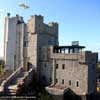
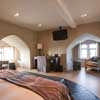
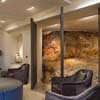

images : Castle Photography in Haverfordwest
Roch Castle is listed Grade 1. The success of the project is in no small measure due to the team approach adopted by the design and construction team and in the early stages to the support and pragmatic approach adopted by the conservation section of the Pembrokeshire Coast National Park Authority.
Consent was given in advance of the formal application to begin clearing the building of it’s more recent (1950’s & 70’s) additions. This process exposed not only the extent of the 1910 re-build but also the poor quality of much of this work. All floors and roofs inserted during this period were found to be a combination of unprotected steel beams with insitu reinforced concrete, and most suffering from extensive and un-repairable levels of corrosion.
Individually tested using carbonation analysis and in discussion with the local authority and SPAB it was agreed that most of the floors and flat roofs could be cut out and replaced using a new pre cast concrete and steel structure. Over a period of six months, the concrete was cut out in sections and floor by floor. The remaining beams and castings were repaired using specialist repair techniques.
All mortars and renders employed in the 1910 restoration were found to be cement based. The 100% removal of internal renders and external pointing not only allowed the introduction of lime based breathing mortars but also facilitated the survey and archaeological recording of the fabric by the archaeological team.
A scaffolding tent was erected over the entire castle in 2009 and remained in position until the spring of 2011. Providing protected working through all but the worst of Pembrokeshire weather, it also allowed the building to dry out over the 2-year period.
Damp control within the building has been a major concern. This has been tackled in 3 ways.
Firstly: by inserting waterproof membranes at roof and parapet level wherever possible and without disturbing medieval work. This included lead trays within re-built parapets and single ply coverings to replace asphalt.
Secondly: by using lime based breathing mortars externally and internally. Externally the walls have been deep pointed using NHL3.5 mortars with a parged finish, augmented by NHL shelter coats to the more exposed square tower. Internally all masonry walls have been plastered using hemp lime.
In places on external walls, insulation has been introduced using Calcitherm boards applied onto a NHL 2 levelling coat and finished with hemp lime render.
Thirdly: and as a back up, humidity is controlled by built in dehumidifiers.
Both the original castle and annexe were built from locally quarried Pennant sandstones, ranging in colour from blue to brown. Numbers of dressed window surrounds dating from 1910 have been repaired using grey Forrest of Dean sandstone. Small areas of decayed medieval masonry were replaced to match, including missing parapet corbels.
The 1910 bronze windows were replaced using new double glazed bronze casement windows, reusing where possible catches and stays.
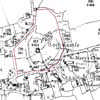
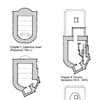
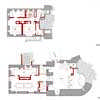
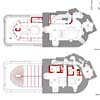
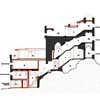
images : Acanthus Holden Architects
• All timber partitions have been clad in wood wool boards, with hemp lime render and sheep’s wool insulation.
• All sanitary ware is Starck Range from Duravit Ltd and Hans Grohe with Bette shower trays and Majestic glass enclosures.
• Stones for the reception room floors is Gascoine Bleu limestone from Portugal supplied by Dimpomar Rochas Portuguesas LDA. Marble is Italian supplied by Beltrami.
• Wood block floors are by V.A.Hutchinson Flooring Ltd.
• All joinery is in limed oak by James Ratford Bridge Ltd.
• Louvered shutters are by The New England Shutter Company Ltd. Blinds from Silent Gliss Ltd.
• The bespoke furnishings were hand crafted by Channels Furniture Company.
• The 4 areas of grounds have been landscaped and planted with over 200 trees. The well and perimeter wall have been restored.
• Bespoke artwork is by local artists .Dan Wright (ceramicist), Amanda Wright (textiles), Brendan Stuart Burns (artist).
• Conservation materials from Ty Mawr Lime Ltd.
• Paints from Keim Ltd and Ecos Organic Paints Co.
• Ironmongery from Frank Allart supplied by The Walters Group.
• Stone Carving by Coe Stone Ltd
• Tiling and showers by Abbey Masonry & Restoration Ltd
• Metal work by Creative Spiral, Pier Engineering ,Kingswood Engineering Ltd and Tumble Forge.
• Structural Glass by APSS Ltd
• Windows by Vale Garden Houses Ltd
• Curtain walling by Kawneer UK Ltd
• Zinc Roofing from VM Zinc installed by Cotswold Metal Roofing Ltd.
• Kitchen by Classic Kitchens, Whitland.
The main contract was tendered on the basis of approximate preliminaries and rates for standard items of works: Subcontracts were tendered and let separately through the main contractor for which a management fee was included. The form of contract used was JCT SBC With Quantities 2005.
The enabling works contract was let on 24thFeb 2009 Listed building consent was granted on 22ndJuly 2009. The reinforced concrete floor replacement was completed on in mid 2009. Practical completion was achieved in January 2012
Roch Castle is a unique project, combining traditional conservation practise with the best of modern design.
Peter Holden
22.2.2012
Roch Castle Wales images / information from Acanthus Holden Architects
Location: Roch Castle, Pembrokeshire, south west Wales, UK
Welsh Architecture
North Wales Building Photos
North Wales Buildings : Photos
Maggie’s Southwest Wales
Kisho Kurokawa Architect & Associates with Garber & James
Maggies Wales
Aberystwyth Creative Units
Heatherwick Studio
Aberystwyth Creative Units
Royal Welsh College of Music & Drama, Cardiff
BFLS
Royal Welsh College of Music & Drama Development
Ray Hole Architects
Snowdon Summit Visitor Centre
Newport Station, Newport
Architect: Grimshaw with Atkins
Newport Station Building
Comments / photos for the Roch Castle Pembrokeshire, Wales page welcome
Website: Roch Castle Pembrokeshire



